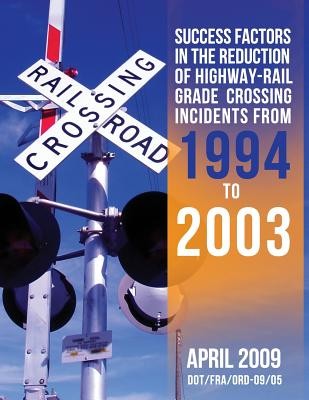
- We will send in 10–14 business days.
- Author: U S Department of Transportation
- Publisher: CreateSpace Independent Publishing Platform
- Year: 2013
- Pages: 130
- ISBN-10: 1494708116
- ISBN-13: 9781494708115
- Format: 21.6 x 28 x 0.7 cm, softcover
- Language: English
- SAVE -10% with code: EXTRA
Success Factors in the Reduction of Highway-Rail Grade Crossing Incidents from 1994 to 2003 (e-book) (used book) | bookbook.eu
Reviews
Description
Between the years 1994 and 2003, incidents at highway-rail grade crossings declined by 41.2 percent. The reasons for this decline were unknown. The John A. Volpe National Transportation Systems Center was tasked by the Federal Railroad Administration to identify the salient success factors in highway-rail grade crossing incident reduction. The success factors were analyzed and investigated using various qualitative and quantitative methods. Ten factors were identified as the most influential safety factors. The ten factors are: Commercial Driver Safety, Locomotive Conspicuity, More Reliable Motor Vehicles, Crossing Closure and Grade Separation, Sight Lines Clearance, Warning Device Upgrades, the Grade Crossing Maintenance Rule, the Section 130 Program, Operation Lifesaver, and Railroad Mergers.
EXTRA 10 % discount with code: EXTRA
The promotion ends in 19d.06:28:54
The discount code is valid when purchasing from 10 €. Discounts do not stack.
- Author: U S Department of Transportation
- Publisher: CreateSpace Independent Publishing Platform
- Year: 2013
- Pages: 130
- ISBN-10: 1494708116
- ISBN-13: 9781494708115
- Format: 21.6 x 28 x 0.7 cm, softcover
- Language: English English
Between the years 1994 and 2003, incidents at highway-rail grade crossings declined by 41.2 percent. The reasons for this decline were unknown. The John A. Volpe National Transportation Systems Center was tasked by the Federal Railroad Administration to identify the salient success factors in highway-rail grade crossing incident reduction. The success factors were analyzed and investigated using various qualitative and quantitative methods. Ten factors were identified as the most influential safety factors. The ten factors are: Commercial Driver Safety, Locomotive Conspicuity, More Reliable Motor Vehicles, Crossing Closure and Grade Separation, Sight Lines Clearance, Warning Device Upgrades, the Grade Crossing Maintenance Rule, the Section 130 Program, Operation Lifesaver, and Railroad Mergers.


Reviews